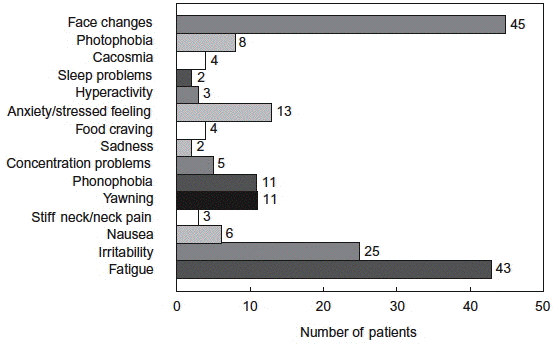- The prevalence and characterization of
premonitory symptoms have not been rigorously
studied in children and adolescents.
-
- Using a questionnaire, Cuvellier et al.
retrospectively studied the prevalence of 15
predefined premonitory symptoms in a
clinic-based population.
-
- In 103 children and adolescents fulfilling
the International Classification of Headache
Disorders, 2nd edn criteria for paediatric
migraine, at least one premonitory symptom was
reported by 69 (67%). The most frequently
reported premonitory symptoms were face changes,
fatigue and irritability.
-
- The mean number of premonitory symptoms
reported per subject was 1.8 (median 2.2). Age,
migraine subtype (with or without aura) and mean
attack frequency per month had no effect on the
mean number of premonitory symptoms reported per
subject.
-
- In conclusion, premonitory symptoms are
frequently reported by children and adolescents
with migraine. Face changes seem to be a
premonitory symptom peculiar to paediatric
migraine.
-
- Migraine affects 4&endash;10% of school-aged
children. It is characterized by periodic,
paroxysmal episodes of headache accompanied by
nausea, vomiting, abdominal pain and intense
desire to sleep. On occasion, dramatic signs
such as hemiparesis, acute confusional states,
ophthalmoparesis or vertigo may precede or
accompany migraine headaches.
-
- Migraine is characterized by a great
variability of phenotypical expressions and it
has long been recognized that migraine headaches
are frequently associated with a constellation
of other non-headache symptoms.
-
- The characterization of premonitory symptoms
has been poorly studied in children and
adolescents.
-
 - Discussion (passage)
-
- The proportion of paediatric migraine
patients reporting premonitory symptoms was
high: 67% of patients reported at least one
symptom.
-
- This high prevalence rate is comparable to
two previous retrospective clinic-based adult
studies, where the rates were 79 and 86.9%, but
in contrast to two other studies, where rates
were about 33%.
-
- On the other hand, some premonitory symptoms
presented by the child were exclusively
identifiable by an external observer (such as
face changes). Premonitory symptoms were
consistently associated with the migraine attack
in 64% of patients, a finding that seems higher
than what has been reported in adults.
-
- The most frequently reported premonitory
symptoms were face changes (44%), fatigue (42%)
and irritability (24%). Face changes (pallor,
shadows under the eyes) seem to be peculiar to
children and adolescents, as they have rarely
been reported in adult studies.
-
- On the other hand, fatigue and irritability
have frequently been reported in adult studies,
with rates of 72%, 46.5% and 25.6% for fatigue,
and 23.4% for irritability. By contrast, some
premonitory symptoms that were reported in
adults, such as mood and behaviour changes,
stiff neck, phonophobia, gastrointestinal
symptoms and yawning, were rarely
reported in our paediatric subjects.
-
- Premonitory symptoms may give insight into
the pathophysiology of migraine as an episodic
dysfunction of trigeminovascular regulation,
probably mediated at the level of the brainstem
. Prodromal symptoms, such as yawning, mood
changes, irritability, hyperactivity and sleep
disturbances, reflect dopaminergic
hypersensitivity, and some of them are mediated
by nitric oxide pathways.
-
- Other symptoms point to a hypothalamic
dysfunction. It has been shown that alterations
in dopaminergic neurotransmission can modulate
clinical susceptibility to migraine and
dopamine, at least in a subgroup of migraine
patients, and can play an important role in
activating the biochemical cascade leading to
the premonitory symptoms, and ultimately to the
migraine attack.
-
- Some authors (15) have postulated that many
premonitorysymptoms might reflect the same
biological mechanism underlying the headache
phase (disinhibition of brainstem nuclei
regulating the amount of pain and other sensory
inputs, and their associated motor and autonomic
activities). In this setting, the fullblown
migraine headache would finally develop when a
critical physiological threshold is
reached.
|


